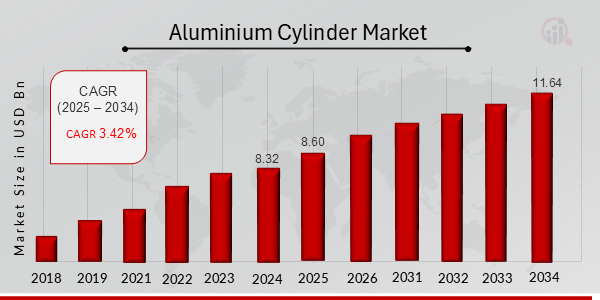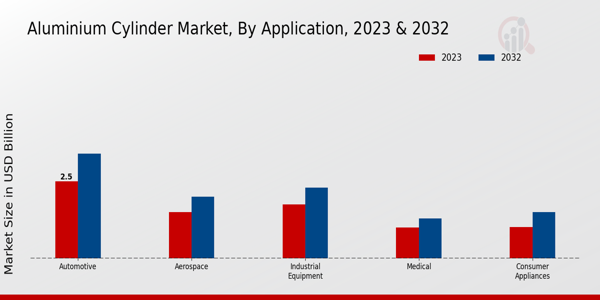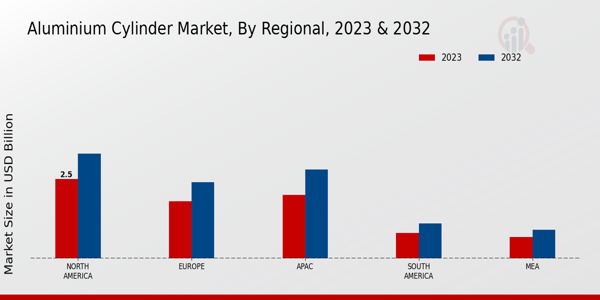Global Aluminium Cylinder Market Overview:
As per MRFR analysis, the Aluminium Cylinder Market Size was estimated at 8.32 (USD Billion) in 2024. The Aluminium Cylinder Market Industry is expected to grow from 8.60 (USD Billion) in 2025 to 11.64 (USD Billion) till 2034, at a CAGR (growth rate) is expected to be around 3.42% during the forecast period (2025 - 2034).
Key Aluminium Cylinder Market Trends Highlighted
The Aluminium Cylinder Market is witnessing notable growth driven by increasing demand for lightweight and corrosion-resistant materials across various industries such as automotive, aerospace, and healthcare. The shift towards sustainable solutions is pushing manufacturers to explore aluminum as a preferred material due to its recyclability and energy efficiency. Additionally, the rising need for high-performance storage solutions for gases and liquids further fuels market expansion. Strong investments in research and development also enhance product innovation, catering to specific industry needs. Opportunities within the market are growing, particularly in emerging economies where industrialization is on the rise.
As the energy sector evolves, there is potential for significant advancements in the use of aluminium cylinders for compressed natural gas and other energy storage applications. The adoption of aluminium cylinders in the beverage industry is also a major opportunity, with manufacturers seeking to replace traditional materials with more durable options. Furthermore, the increasing focus on lightweight packaging and environmentally friendly solutions presents new avenues for growth. Recent trends indicate a push towards automation and advanced manufacturing processes in the production of aluminium cylinders. Techniques such as 3D printing and advanced machining are becoming more prevalent, allowing for custom designs that meet specific customer needs.
Sustainability is also a defining factor, with many companies committing to reducing their carbon footprint by adopting greener practices. As the market evolves, adopting digital technologies and smart manufacturing will likely reshape how aluminium cylinders are produced and utilized, fostering greater efficiency and reducing waste. Overall, the industry is adapting to the changing landscape, positioning itself to meet future challenges and demands effectively.

Source: Primary Research, Secondary Research, MRFR Database and Analyst Review
Aluminium Cylinder Market Drivers
Rising Demand for Lightweight Materials
A crucial factor for the Aluminium Cylinder Market Industry is the rising necessity for light materials to be used in different fields. Aluminium possesses an even lower density than other metals, which makes it ideal for industries such as automotive, aerospace, and consumer products. However, as manufacturers look for improved fuel economy and lower emissions, there appears to be a growing market for the use of aluminium cylinders. By using aluminium in their goods, firms can use a lot less weight than traditional materials such as steel.
This trend is most pronounced in the automotive sector, where demand for emissions reductions and fuel consumption efficiency are increasing. Additionally, improvements in technology and production are also enhancing the performance and longevity of aluminum cylinders, which in turn has contributed to their acceptance in high-performance applications. It follows that not only are aluminum’s lightweight properties meritorious from a performance perspective, but they are also essential from a sustainability standpoint, which makes this driver an important one for the future development of the market as well.
Increasing Applications in the Automotive Sector
The automotive sector is increasingly adopting aluminium cylinders due to their beneficial properties. Lightweight materials can help reduce overall vehicle weight, which directly contributes to improved fuel efficiency. As electric vehicles and hybrid models continue to gain traction, the demand for lightweight components, including aluminium cylinders, is expected to grow. The Aluminium Cylinder Market Industry is thus benefitting from this trend as automotive manufacturers seek to optimize vehicle performance while adhering to environmental regulations.
Growing Focus on Sustainable Practices
Sustainability is becoming a fundamental aspect of product development across industries. The Aluminium Cylinder Market Industry is experiencing growth due to the focus on sustainable manufacturing practices. Aluminium is highly recyclable, and its use in cylinder production aligns with the push for reduced environmental impact. Companies that prioritize eco-friendly practices are turning to aluminium cylinders as a more sustainable choice, driving demand in the market.This concern for sustainability among consumers and regulatory bodies is essential for the industry's long-term prospects.
Aluminium Cylinder Market Segment Insights:
Aluminium Cylinder Market Application Insights
The Aluminium Cylinder Market is experiencing steady growth, with a projected revenue of 7.77 USD Billion in 2023, reflecting strong demand across various applications. This market is characterized by its segmentation into several key areas, notably Automotive, Aerospace, Industrial Equipment, Medical, and Consumer Appliances. The Automotive sector holds a significant position within this market, valued at 2.5 USD Billion in 2023 and projected to reach 3.4 USD Billion by 2032, indicating its dominant role as industries seek lightweight materials for fuel efficiency and performance. Following closely is the Aerospace application, valued at 1.5 USD Billion in 2023 and expected to attain 2.0 USD Billion in 2032. The aerospace industry's need for durable yet lightweight components further emphasizes the growth potential for aluminium cylinders in this area.
In addition, the Industrial Equipment segment represents an important part of the market, with a valuation of 1.75 USD Billion in 2023, rising to 2.3 USD Billion by 2032, highlighting the ongoing demand for efficient machinery and tools across sectors. The Medical application, valued at 1.0 USD Billion in 2023, anticipates growth to 1.3 USD Billion by 2032, driven by increased healthcare needs and the demand for reliable medical devices. Lastly, the Consumer Appliances application, valued at 1.02 USD Billion in 2023, is expected to increase to 1.5 USD Billion by 2032, underscoring the role of aluminium cylinders in household products and innovations aimed at energy efficiency and sustainability.
This segmentation of the Aluminium Cylinder Market not only showcases varying degrees of market growth but also reflects the broader trends of technological advancement and materials efficiency across industries. The trends indicate that the demand for lightweight, durable, and corrosion-resistant materials will continue to drive the expansion of the aluminium cylinder market. Additionally, awareness regarding sustainability and environmental compliance propels growth in specific applications such as automotive and aerospace, where the weight of components directly impacts fuel efficiency and operational costs. The challenges that this market faces include fluctuations in raw material prices and competition from alternative materials, yet the growing applications across diverse sectors present significant opportunities for the Aluminium Cylinder Market to thrive. Overall, as industries increasingly embrace aluminium's benefits, the market is set for consistent growth, bolstered by innovations and advancements in material technology.

Source: Primary Research, Secondary Research, MRFR Database and Analyst Review
Aluminium Cylinder Market Product Type Insights
The Aluminium Cylinder Market, valued at 7.77 billion USD in 2023, showcases distinct Product Type segments, including Seamless Cylinders, Welded Cylinders, and Composite Cylinders, each playing a vital role in the industry. Seamless Cylinders are particularly notable for their structural integrity and reliability, making them a preferred choice for high-pressure applications. Welded Cylinders, often more cost-effective, cater to a range of storage and transportation needs, appealing to various industrial sectors. Composite Cylinders are gaining traction due to their lightweight properties and corrosion resistance, making them suitable for diverse applications in specialized markets.The continuous evolution of these categories is propelled by increasing demand for efficient and durable storage solutions, while challenges such as raw material costs and competition from alternative materials persist. Market growth is fortified by rising industrial activities and a shift towards environmentally friendly solutions, revealing significant opportunities for innovation and product development. As the market landscape evolves, comprehensive Aluminium Cylinder Market data, along with Aluminium Cylinder Market statistics, will be essential in understanding future trends and dynamics.
Aluminium Cylinder Market End Use Insights
The Aluminium Cylinder Market, valued at 7.77 USD Billion in 2023, is witnessing substantial growth across its various end-use applications. The market is primarily segmented into Energy Storage, Fuel Storage, Transportation, and Manufacturing, each playing an essential role in driving demand. The Energy Storage sector is significant as it supports renewable energy integration and efficient energy transition, driven by an increasing need for sustainable solutions. Fuel Storage remains a crucial area, as aluminum's lightweight and corrosion resistance make it ideal for storing various fuels safely and efficiently.Transportation is another dominant segment, benefiting from the trend towards lightweight materials in vehicles, enhancing fuel efficiency and reducing emissions. Manufacturing also sees significant utilization of aluminium cylinders, particularly in sectors that prioritize durability and performance in their production processes. With a broad range of applications indicating a robust and evolving landscape, the Aluminium Cylinder Market statistics reflect ongoing trends of innovation, sustainability, and efficiency that boost the industry's growth and expansion opportunities.
Aluminium Cylinder Market Diameter Insights
The Aluminium Cylinder Market, focusing on the Diameter segment, encompasses a diverse range of applications and products that provide value across various industries. In 2023, the market reached a valuation of 7.77 billion USD, demonstrating the growing demand for lightweight and durable aluminium cylinders. The segmentation into Small Diameter, Medium Diameter, and Large Diameter plays a crucial role in this growth. Small Diameter cylinders are increasingly utilized in specialized applications, including medical and industrial sectors, where precision and safety are essential.Medium Diameter cylinders serve versatile purposes in consumer goods and industrial applications, making them significant within the market. Meanwhile, Large Diameter cylinders are often favored in sectors such as construction and energy, catering to massive storage needs and transportability. As manufacturers continue to innovate and cater to the specific needs of each diameter category, the Aluminium Cylinder Market experiences steady growth, driven by advancements in technology and increasing sustainability efforts in material use. This segment's trends highlight an increasing focus on efficiency and performance, presenting ample opportunities for future expansion within the market.Overall, the market reflects a dynamic interplay of demand and innovation across its diameter-oriented segmentation, providing substantial insights into the industry's direction and potential.
Aluminium Cylinder Market Regional Insights
The Aluminium Cylinder Market revenue, valued at 7.77 USD Billion in 2023, presents a diverse landscape across various regional segments, including North America, Europe, APAC, South America, and MEA. North America dominates with a valuation of 2.5 USD Billion in 2023 and is projected to reach 3.3 USD Billion by 2032, showcasing its significant industrial applications and strong demand in sectors like automotive and aerospace. Europe follows with a valuation of 1.8 USD Billion in 2023, contributing to the market's growth due to its robust manufacturing base and increasing focus on lightweight materials for sustainability.The APAC region, valued at 2.0 USD Billion in 2023, is emerging rapidly as a key player, driven by its booming manufacturing sector and increasing investment in infrastructure. South America and MEA represent smaller portions of the market, valued at 0.8 USD Billion and 0.67 USD Billion in 2023, respectively, but they still offer growth potential as industrialization progresses in these areas. Consequently, the Aluminium Cylinder Market statistics reveal a balanced growth trajectory across these regions, underpinned by industrial demand and evolving applications.

Source: Primary Research, Secondary Research, MRFR Database and Analyst Review
Aluminium Cylinder Market Key Players and Competitive Insights:
The Aluminium Cylinder Market has witnessed a significant transformation in recent years, driven by factors such as the rising demand for lightweight materials and the increasing applications of aluminium cylinders across various industries, including transportation, energy, and chemical processing. The competition in this market is robust, with numerous established players and new entrants striving to carve out their share. Companies are focusing on innovation in manufacturing processes, enhancing product quality, and diversifying their offerings to meet the specific needs of their customers. Additionally, strategic partnerships, mergers and acquisitions, as well as investments in technology and sustainability initiatives, are crucial strategies employed by market players to maintain competitiveness and address emerging market requirements.BAE Systems holds a prominent position in the Aluminium Cylinder Market, leveraging its extensive experience in advanced materials and engineering capabilities. The company's strengths lie in its commitment to innovation, consistent quality assurance, and robust customer relationships. BAE Systems focuses on integrating cutting-edge technology into their aluminium cylinder production, enabling them to produce high-strength, lightweight cylinders that meet stringent industry standards. Their strong research and development team plays a pivotal role in creating value-added products that cater to diverse market applications. Furthermore, BAE Systems maintains a solid footprint, which enhances its ability to serve customers in different regions effectively. The company's established reputation for reliability and technical support amplifies its competitive advantage within this specialized market segment.Parkland Fuel Corporation is another key player in the Aluminium Cylinder Market, recognized for its strategic focus on fuel distribution and energy solutions. The company benefits from its strong operational network, providing it with the capability to deliver aluminium cylinders consistently across various sectors. Parkland Fuel Corporation emphasizes sustainability in its operations, contributing positively to the market's growing emphasis on environmentally friendly practices. The company's dedication to quality management is reflected in its innovative approaches to product development and operational efficiency. Parkland Fuel Corporation also invests in technology, helping to streamline processes and improve customer service. By aligning its business objectives with market demand and consumer trends, Parkland Fuel Corporation establishes itself as a competitive force within the aluminium cylinder landscape.
Key Companies in the Aluminium Cylinder Market Include:
- BAE Systems
- Parkland Fuel Corporation
- Nanjing JIANGNAN
- Linde
- Worthington Industries
- Continental Structural Plastics
- Air Liquide
- Maharashtra Cylinders
- MetalMate
- Energoprogress
- Tianhai Longsheng
- Faber Industrie
- Norris Cylinder
- Luxfer Gas Cylinders
- Trafag AG
Aluminium Cylinder Market Industry Developments
Recent developments in the Aluminium Cylinder Market have been focusing on increasing demand due to the surge in applications across various industries such as automotive, aerospace, and energy storage. Companies like Linde and Air Liquide are enhancing their production capabilities to meet the growing needs of industrial gases, while Worthington Industries is expanding its footprint in the renewable energy sector, prompting an uptick in aluminium cylinder usage. In terms of mergers, recent acquisitions have been notable; for instance, Trafag AG has strengthened its market position through strategic partnerships aimed at enhancing operational efficiency. Additionally, Luxfer Gas Cylinders has highlighted growth in market valuation attributable to an increase in demand for lightweight, high-performance cylinders, significantly impacting market dynamics positively. Continental Structural Plastics is also seeing growth through its innovation in composite cylinder designs, while Nanjing JIANGNAN remains focused on technological advancements to boost production. The overall landscape reflects a vibrant market, propelled by both technological innovations and strategic business moves among key players like BAE Systems, Parkland Fuel Corporation, and Maharashtra Cylinders, which is paving the way for future developments within the industry.
Aluminium Cylinder Market Segmentation Insights
- Aluminium Cylinder Market Application Outlook
- Automotive
- Aerospace
- Industrial Equipment
- Medical
- Consumer Appliances
- Aluminium Cylinder Market Product Type Outlook
- Seamless Cylinders
- Welded Cylinders
- Composite Cylinders
- Aluminium Cylinder Market End Use Outlook
- Energy Storage
- Fuel Storage
- Transportation
- Manufacturing
- Aluminium Cylinder Market Diameter Outlook
- Small Diameter
- Medium Diameter
- Large Diameter
- Aluminium Cylinder Market Regional Outlook
- North America
- Europe
- South America
- Asia Pacific
- Middle East and Africa
| Report Attribute/Metric |
Details |
|
Market Size 2024
|
8.32 (USD Billion)
|
|
Market Size 2025
|
8.60 (USD Billion)
|
|
Market Size 2034
|
11.64 (USD Billion)
|
|
Compound Annual Growth Rate (CAGR)
|
3.42% (2025 - 2034)
|
|
Report Coverage
|
Revenue Forecast, Competitive Landscape, Growth Factors, and Trends
|
|
Base Year
|
2024
|
|
Market Forecast Period
|
2025 - 2034
|
|
Historical Data
|
2019 - 2023
|
| Market Forecast Units |
USD Billion |
| Key Companies Profiled |
BAE Systems, Parkland Fuel Corporation, Nanjing JIANGNAN, Linde, Worthington Industries, Continental Structural Plastics, Air Liquide, Maharashtra Cylinders, MetalMate, Energoprogress, Tianhai Longsheng, Faber Industrie, Norris Cylinder, Luxfer Gas Cylinders, Trafag AG |
| Segments Covered |
Application, Product Type, End Use, Diameter, Regional |
| Key Market Opportunities |
Increasing demand in the automotive sector, Growth in renewable energy storage, Expanding industrial applications in manufacturing, Rising focus on lightweight materials, Innovating recyclable aluminium solutions |
| Key Market Dynamics |
rising demand in the automotive sector, increasing focus on lightweight materials, growth in aerospace applications, stringent environmental regulations, advancements in manufacturing technologies |
| Countries Covered |
North America, Europe, APAC, South America, MEA |
Frequently Asked Questions (FAQ) :
The Aluminium Cylinder Market is expected to be valued at 11.64 USD Billion by 2034.
The expected CAGR for the Aluminium Cylinder Market from 2025 to 2034 is 3.42%.
North America is projected to have the largest market share in the Aluminium Cylinder Market, valued at 3.3 USD Billion by 2032.
The Automotive application segment is expected to be valued at 3.4 USD Billion by 2032.
Major players in the Aluminium Cylinder Market include BAE Systems, Linde, and Worthington Industries, among others.
The Aerospace application segment is projected to reach a value of 2.0 USD Billion by 2032.
The market size of the Aluminium Cylinder Market in North America is valued at 2.5 USD Billion for 2023.
The Industrial Equipment segment is valued at 2.3 USD Billion in the Aluminium Cylinder Market by 2032.
The Medical application segment is expected to be valued at 1.3 USD Billion by 2032.
The Consumer Appliances application segment is expected to grow to 1.5 USD Billion by 2032.

















